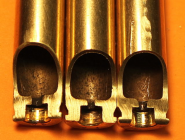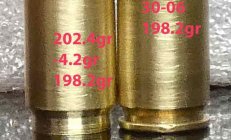ronemus
Gold $$ Contributor
One way to approach this question with a minimum number of loaded/fired rounds is simply to choose about 5 cases from each end of the weight spectrum (i.e. both extreme low and extreme high weights from within the total range). Load them identically in terms of charge weight, seating depth, primer, etc., then determine an average velocity for the "light" and "heavy" groups for direct comparison.
I did an experiment several years ago to determine just how much effect brass weight has on .223 loads. I used WW brass (sized, trimmed and deburred, primer pockets uniformed, flash holes deburred, and neck turned) , WSR primers, charges of RL-15 or N-550 powder weighed to 0.1 gr, and 75 gr A-Max bullets. Using the lightest and heaviest cases (sorted from 1000 once-fired I had on hand), I had two lots of 10 cases with a 3 gr difference in weight. The average muzzle velocity difference was 16 fps, just a bit more than the 12 fps due to 0.1 gr of powder. I choose to sort 0.5 gr lots of .223 brass for my long range loads, but the effect will only matter at 800-1000 yards - the vertical displacement on the target from such a small velocity change is negligible at shorter distances. Unless you control all other sources of variation, the effect of brass weight is negligible.
I also shoot .284, and because the brass is twice as heavy I batch in 1 gr lots.
I shoot .338 Lapua Magnum with brass weighing what a .223 does, but I have too few cases to sort into reasonably sized lots. I sort them in sequential order instead - a 10- or 20-shot string will have a spread of <1 gr, so elevation won't be affected significantly.


















